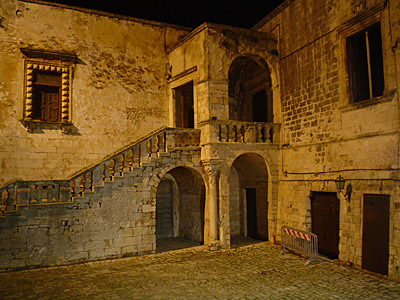CEGLIE
MESSAPICA
Half way along the road between
Brindisi and Taranto, is where Ceglie is situated.
It is an
ancient centre founded by the Messapians by the name of Kaìlia;
a Messapian stronghold also known as dodecapoli deriving from
the 12 cities it encompassed: Alytia (Alezio), Ozan (Ugento),
Brention/Brentesion (Brindisi), Hyretum/Veretum (Vereto),
Hodrum/Idruntum (Otranto), Kaìlia (Ceglie Messapica),
Manduria, Mesania (Mesagne), Neriton (Nardò), Orra
(Oria), Cavallino, Thuria Sallentina (Roca Vecchia).
In the City and surrounding territory, there are some ancient
remains such as: the 19 mirrors, some stones of varying dimensions
which were once lookout towers (the larger) and tombs containing
funeral objects (the smaller).
The defensive function of Ceglie is confirmed by its four
City walls, built during the Messapian era, which protected
the City from the Greeks of Taranto, who continuously tried
to acquire an outlet along the Adriatic coastal area.
The clash between the two Greek civilisations and Messapica,
ended in the defeat of Taranto in 473 BC, due to a strong
Messapian cavalry.
During the III Century BC, after the campaigns of Pirro in
Italy in defence of Greek Taranto, the entire region fell
under the influence of Rome (275 BC) and took on the name
of Caelium.
Not much is known about the Imperial period, but it is probable
that Ceglie was an important locality as demonstrated by the
finds of temples in its historical centre.
After the fall of the Roman Empire (476 AD), Ceglie experienced
devastation and siege by the Goths of Alarico and the Vandals.
It was subjected to annexation and ephemeral reign by the
Ostrogoths (476-535), then fell into the hands of the Byzantines,
as with all of Puglia (553), for about twenty years, until
the arrival of the Longobards of Alboino, who named it Ceglie
of the Forest.
After Norman domination (11th Century AD) and that of the
Swabians (13th Century), the City passed hands to the Angioini
and was given as a dowry for Eleonora, Carlo II of Angiò’s
daughter.
During the 15th Century, Ceglie was governed by the Diocese
of Brindisi and then yielded in exchange to Ferdinardo Sanseverino,
who amplified the Castle by building the square tower. This
family was succeeded by the Luperano and the Sisto y Britto,
who took Ceglie from Bourbon reign to the new Reign of Italy
(1860).
Ceglie Messapica can be entered via two doors: Giuso and Monterone.
From here, through a sinuous path, one will arrive at the
climb up to the “Centro Scaloni,” existing since
Messapian times and updated during the Medieval period. It
leads to the Castle area.
The village centre is dominated by the presence of the Castle,
initiated during Norman times (11th Century AD), and built
on the same site of the Hellenistic Acropolis and main Roman
temples.
Close by, one can also visit the Matrix Church, which took
on its present Baroque look during the ‘700s.
There are also visible traces, in Ceglie Messapica, of a mural
wall, known as Paretone.
Outside the City, one can visit the Madonna della Grotta Church,
which houses frescoes from the 13th Century and the S. Michele
Grotto with frescoes from the 8th Century.
The grottos of Montevicoli, which were frequented during the
Messapian era, as demonstrated by finds of inscriptions, are
also interesting.
|
